AMD's Radeon HD 5870: Bringing About the Next Generation Of GPUs
by Ryan Smith on September 23, 2009 9:00 AM EST- Posted in
- GPUs
Cypress: What’s New
With our refresher out of the way, let’s discuss what’s new in Cypress.
Starting at the SPU level, AMD has added a number of new hardware instructions to the SPUs and sped up the execution of other instruction, both in order to improve performance and to meet the requirements of various APIs. Among these changes are that some dot products have been reduced to single-cycle computation when they were previously multi-cycle affairs. DirectX 11 required operations such as bit count, insert, and extract have also been added. Furthermore denormal numbers have received some much-needed attention, and can now be handled at full speed.
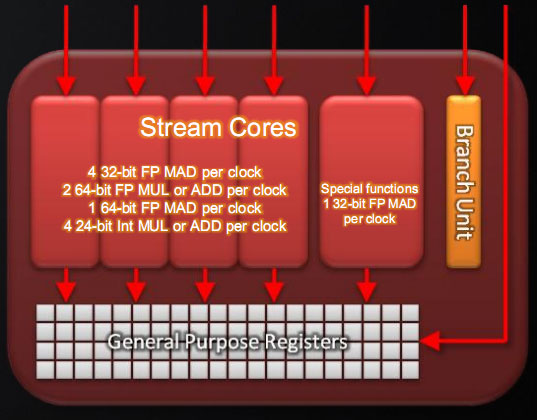
Perhaps the most interesting instruction added however is an instruction for Sum of Absolute Differences (SAD). SAD is an instruction of great importance in video encoding and computer vision due to its use in motion estimation, and on the RV770 the lack of a native instruction requires emulating it in no less than 12 instructions. By adding a native SAD instruction, the time to compute a SAD has been reduced to a single clock cycle, and AMD believes that it will result in a significant (>2x) speedup in video encoding.
The clincher however is that SAD not an instruction that’s part of either DirectX 11 or OpenCL, meaning DirectX programs can’t call for it, and from the perspective of OpenCL it’s an extension. However these APIs leave the hardware open to do what it wants to, so AMD’s compiler can still use the instruction, it just has to know where to use it. By identifying the aforementioned long version of a SAD in code it’s fed, the compiler can replace that code with the native SAD, offering the native SAD speedup to any program in spite of the fact that it can’t directly call the SAD. Cool, isn’t it?
Last, here is a breakdown of what a single Cypress SP can do in a single clock cycle:
- 4 32-bit FP MAD per clock
- 2 64-bit FP MUL or ADD per clock
- 1 64-bit FP MAD per clock
- 4 24-bit Int MUL or ADD per clock
- SFU : 1 32-bit FP MAD per clock
Moving up the hierarchy, the next thing we have is the SIMD. Beyond the improvements in the SPs, the L1 texture cache located here has seen an improvement in speed. It’s now capable of fetching texture data at a blistering 1TB/sec. The actual size of the L1 texture cache has stayed at 16KB. Meanwhile a separate L1 cache has been added to the SIMDs for computational work, this one measuring 8KB. Also improving the computational performance of the SIMDs is the doubling of the local data share attached to each SIMD, which is now 32KB.
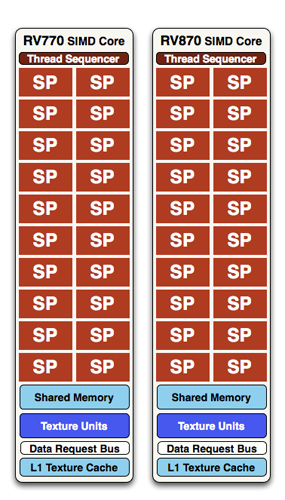
At a high level, the RV770 and Cypress SIMDs look very similar
The texture units located here have also been reworked. The first of these changes are that they can now read compressed AA color buffers, to better make use of the bandwidth they have. The second change to the texture units is to improve their interpolation speed by not doing interpolation. Interpolation has been moved to the SPs (this is part of DX11’s new Pull Model) which is much faster than having the texture unit do the job. The result is that a texture unit Cypress has a greater effective fillrate than one under RV770, and this will show up under synthetic tests in particular where the load-it and forget-it nature of the tests left RV770 interpolation bound. AMD’s specifications call for 68 billion bilinear filtered texels per second, a product of the improved texture units and the improved bandwidth to them.
Finally, if we move up another level, here is where we see the cause of the majority of Cypress’s performance advantage over RV770. AMD has doubled the number of SIMDs, moving from 10 to 20. This means twice the number of SPs and twice the number of texture units; in fact just about every statistic that has doubled between RV770 and Cypress is a result of doubling the SIMDs. It’s simple in concept, but as the SIMDs contain the most important units, it’s quite effective in boosting performance.
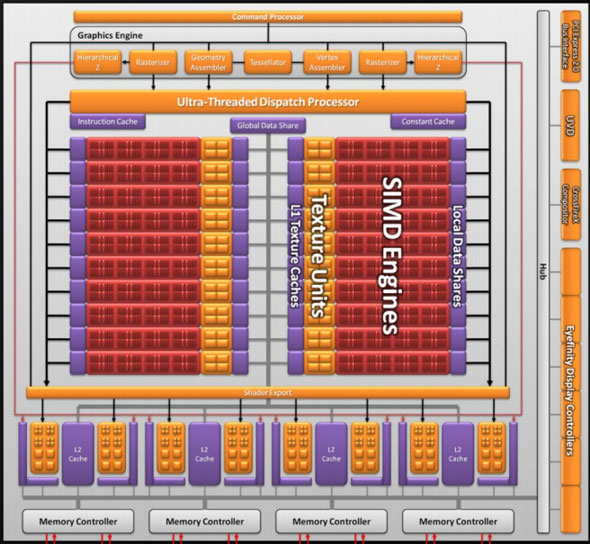
However with twice as many SIMDs, there comes a need to feed these additional SIMDs, and to do something with their products. To achieve this, the 4 L2 caches have been doubled from 64KB to 128KB. These large L2 caches can now feed data to L1 caches at 435GB/sec, up from 384GB/sec in RV770. Along with this the global data share has been quadrupled to 64KB.
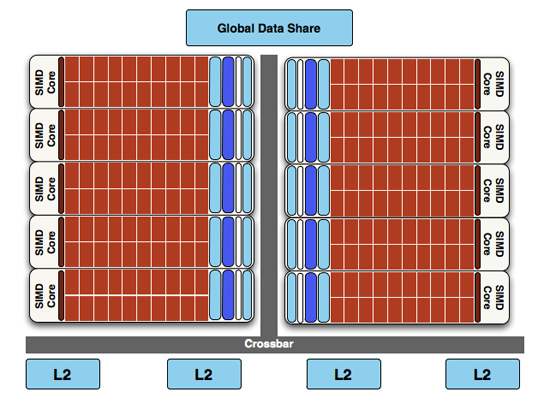
RV770 vs...
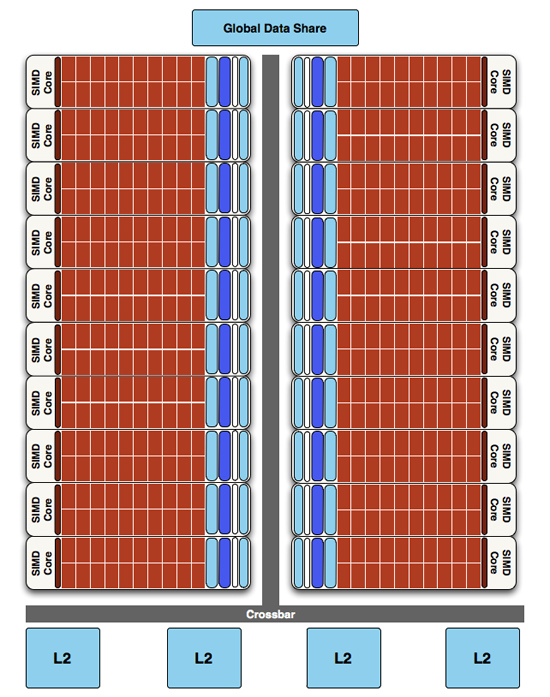
Cypress
Next up, the ROPs have been doubled in order to meet the needs of processing data from all of those SIMDs. This brings Cypress to 32 ROPs. The ROPs themselves have also been slightly enhanced to improve their performance; they can now perform fast color clears, as it turns out some games were doing this hundreds of times between frames. They are also responsible for handling some aspects of AMD’s re-introduced Supersampling Anti-Aliasing mode, which we will get to later.

Last, but certainly not least, we have the changes to what AMD calls the “graphics engine”, primarily to bring it into compliance with DX11. RV770’s greatly underutilized tessellator has been upgraded to full DX11 compliance, giving it Hull Shader and Domain Shader capabilities, along with using a newer algorithm to reduce tessellation artifacts. A second rasterizer has also been added, ostensibly to feed the beast that is the 20 SIMDs.










327 Comments
View All Comments
erple2 - Wednesday, September 23, 2009 - link
I think that you're missing the point. AMD appeared to want the part to be small enough to maximize the number of gpu's generated per wafer. They had their own internal idea of how to get a good yield from the 40nm wafers.It appears to be similar to their line of thinking with the 4870 launch (see http://www.anandtech.com/video/showdoc.aspx?i=3469">http://www.anandtech.com/video/showdoc.aspx?i=3469 for more information) - they didn't feel like they needed to get the biggest, fastest, most power hungry part to compete well. It turns out that with the 5870, they have that, at least until we see what Nvidia comes out with the G300.
It turns out that performance really isn't all people care about - otherwise nobody would run anything other than dual GTX285's in SLI. People care about performance __at a particular price point__. ATI is trying to grab that particular sweet spot - be able to take the performance crown for a particular price range. They would probably be able to make a gargantuan low-yield, high power monster that would decimate everything currently available (crossfire/SLI or single), but that chip would be massively expensive to produce, and surprisingly, be a poor Return on Investment.
So the comment that Cypress is "too big" I think really is apropos. I think that AMD would have been able to launch the 5870 at the $299 price point of the 4870 only if the die had been significantly smaller (around the same size as the 4870). THAT would have been an amazing bang-for-buck card, I believe.
Doormat - Wednesday, September 23, 2009 - link
[Big Chart] and suchfaxon - Wednesday, September 23, 2009 - link
page 15 is missing its charts guys! look at it, how did that happen lmaoGary Key - Wednesday, September 23, 2009 - link
Ryan is updating the page now. He should be finished up shortly. We had a lot of images that needed to be displayed in a different manner at the last minute.Totally - Wednesday, September 23, 2009 - link
the images are missingdguy6789 - Wednesday, September 23, 2009 - link
You very clearly fail to mention that the cheapest GTX295 one can buy is nearly $100 more expensive than the HD 5870.Ryan Smith - Wednesday, September 23, 2009 - link
In my own defense, when I wrote that paragraph Newegg's cheapest brand-new GTX 295 was only $409. They've been playing price games...SiliconDoc - Friday, September 25, 2009 - link
That "price game" is because the 5870 is rather DISAPPOINTING when compared to the GTX295.I guess that means ATI "blew the competition" this time, huh, and NVidia is going to get more money for their better GTX295.
LOL
That's a *scowl* "new egg price game" for red fans.
Thanks ATI for making NVidia more money !
strikeback03 - Wednesday, September 23, 2009 - link
lol, did they drop the price while they had 5870s in stock, then raise it again once they were gone?SiliconDoc - Wednesday, September 23, 2009 - link
Oh, so sorry, 1:46pm, NO 5870's available at the egg...I guess they sold 1 powercolor and one asus...
http://www.newegg.com/Product/ProductList.aspx?Sub...">http://www.newegg.com/Product/ProductLi...1&na...
---
Come on anandtech workers, you can say it "PAPER LUANCH !"